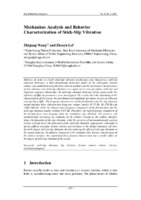Mechanism Analysis and Behavior Characterization of Stick-Slip Vibration

Megtekintés/
Metaadat
Teljes megjelenítés
Link a dokumentumra való hivatkozáshoz:
Gyűjtemény
Absztrakt
In order to clarify stick-slip vibration mechanisms and characterize stick-slip
vibration behaviors, a three-dimensional numerical model of the slider-plate friction
contact was established using the finite element method, and the mechanism characteristics
of slip vibration and stick-slip vibration were analyzed in terms of contact stick-slip and
vibration responses. Meanwhile, the stick-slip vibration behaviors of the system under the
influence of different parameters were investigated. The results show that depending on the
vibration form of the system, the distribution and amplitude of contact stresses in adhesion
and slip states differ. The frequency domain curve of the friction force for the slip vibration
mainly includes three characteristic frequency ranges, namely, 0~75 Hz, 80~150 Hz and
1300~1600 Hz, while the characteristic frequency component of the friction force for the
stick-slip vibration mainly exhibits 0~65 Hz. Therefore, the high-frequency component of
the friction force may originate from the continuous slip vibration. The presence and
monotonically increasing (or constant) of the relative velocity at the contact interface
drives the formation of the slip vibration, while the presence of non-monotonically varying
relative velocity drives the formation of the stick-slip vibration. Appropriate reductions in
spring stiffness and plate motion velocity and increases in the damper damping will slow
down the degree of stick-slip vibration, thereby reducing the effect of stick-slip vibration on
the system behavior. In addition, compared to the constant value friction characteristic of
the contact interface, the exponential decay friction characteristic has a smaller effect on
the degree of stick-slip vibration of the system.
- Cím és alcím
- Mechanism Analysis and Behavior Characterization of Stick-Slip Vibration
- Szerző
- Wang, Zhiqiang
- Lei, Zhenyu
- Megjelenés ideje
- 2025
- Hozzáférés szintje
- Open access
- ISSN, e-ISSN
- 1785-8860
- Nyelv
- en
- Terjedelem
- 21 p.
- Tárgyszó
- stick-slip vibration, slip vibration, friction contact, relative velocity, mechanism property
- Változat
- Kiadói változat
- Egyéb azonosítók
- DOI: 10.12700/APH.22.3.2025.3.12
- A cikket/könyvrészletet tartalmazó dokumentum címe
- Acta Polytechnica Hungarica
- A forrás folyóirat éve
- 2025
- A forrás folyóirat évfolyama
- 22. évf.
- A forrás folyóirat száma
- 3. sz.
- Műfaj
- Tudományos cikk
- Tudományterület
- Műszaki tudományok - gépészeti tudományok
- Egyetem
- Óbudai Egyetem
